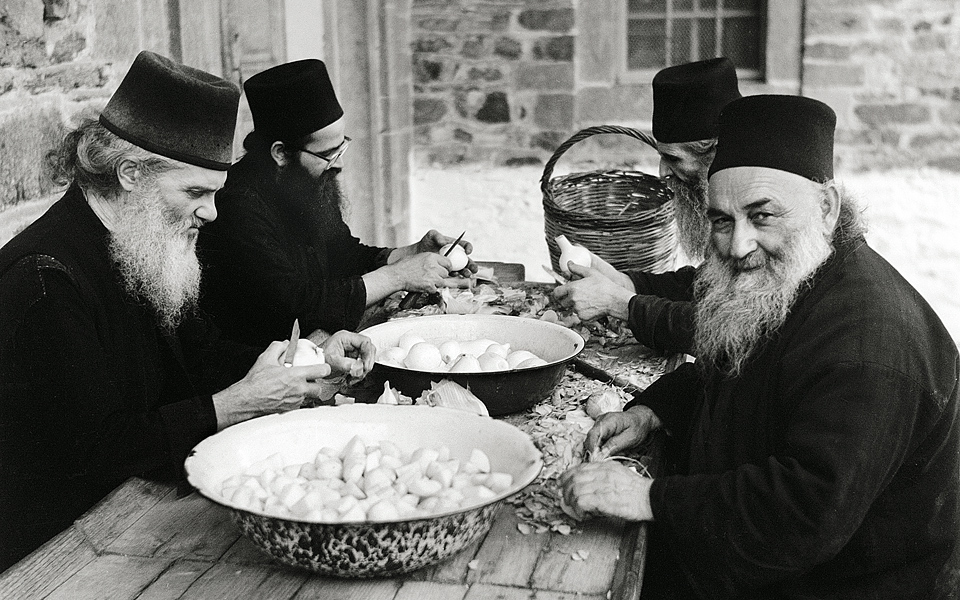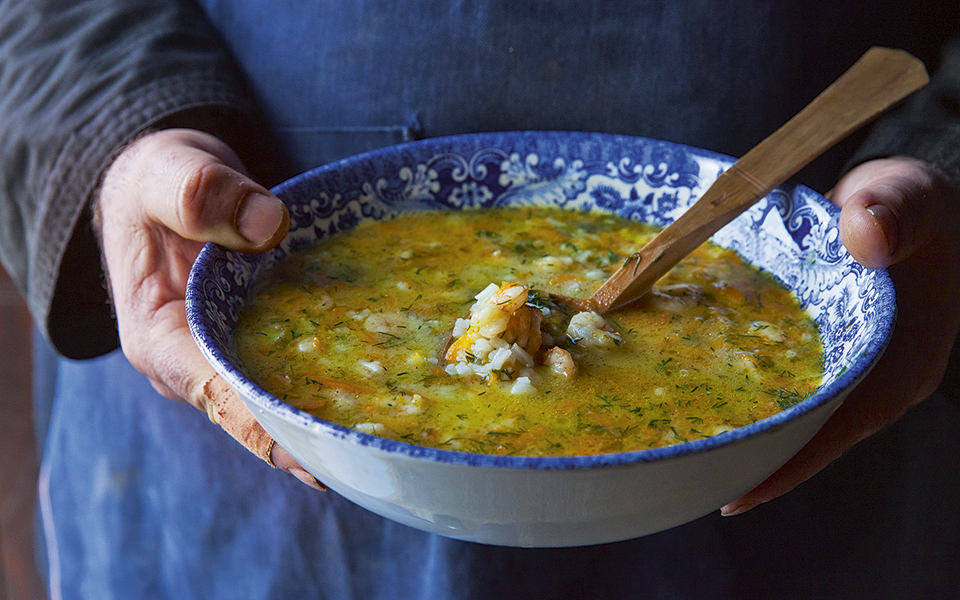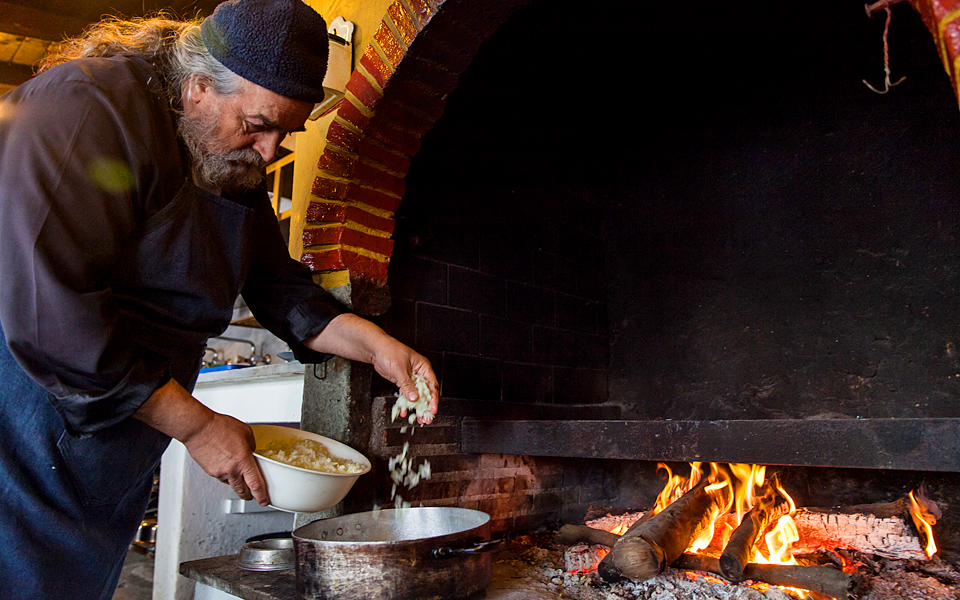The diet of the monks on Mt. Athos is governed by and adheres strictly to the fasting rules of the Eastern Orthodox Church. Like all men, monks are a composite union of soul and body. Monks constantly pray and read sacred texts for the salvation of the soul. In addition to prayer, chanting devotional hymns and readings, the monks are also obliged to perform work. This is required by the communal rules for two reasons: On the one hand, the work undertaken brings some material benefit, while on the other, the work assigned to each monk exercises the body. The jobs performed by each monk are collectively known as diakonimata, which means obediences or offerings.
The monks had always been engaged in farming, fishing, librarianship, art, etc. The goods produced by farming were used to feed not only the monks themselves but also pilgrims visiting the monasteries. The same is true today. The diakonima of the cook is both a work of love and a substantive offering. With his culinary skills, imagination and generous “portion” of love, the cook is obliged to lift the weight and relieve the aggravation of the fasting that must be observed by the monks. In all the refectories or kitchens of Mt. Athos there are icons of the Blessed Virgin and of St. Euphrosynus, patron saint of cooks, in front of which a candle burns continuously. Before preparing a meal, the cook seeks the blessing of the Virgin and St. Euphrosynus to help him achieve a perfect result.
“With his culinary skills, imagination and generous “portion” of love, the cook is obliged to lift the weight and relieve the aggravation of the fasting that must be observed by the monks”

© Nikolaos Tombazis/Benaki Museum Photographic Archives, Ephorate of Antiquities of Chalkidiki and Mount Athos/Hellenic Republic, Ministry of Culture and Sports/Archaeological Receipts Fund
The most important fasting period in the liturgical calendar of Eastern Orthodox Christianity is Great Lent. This is a period of preparation for Christians, both spiritual and physical, an exercise in spiritual upliftment which helps purify them so they can celebrate the feast of the Resurrection. It is not by chance that the fasting of Great Lent coincides with the coming of spring. As we emerge from winter, our body needs to detoxify or rid itself of substances that have built up during that season. Very wisely, the Fathers of the Church timed the Great Lent fast to coincide with the onset of spring.
The rules and restrictions applicable during Great Lent and more generally in all periods of fasting oblige the monk-cook to adopt a different method of cooking. He uses more herbs and spices and less olive oil. The main foodstuffs are vegetables, legumes, cereals, mushrooms, shellfish and marine molluscs. At times of very strict fasting, he will also use plenty of tahini (sesame paste).
“The rules and restrictions applicable during Great Lent and more generally in all periods of fasting oblige the monk-cook to adopt a different method of cooking”

© Dimitris Vlaikos

© Dimitris Vlaikos
VERY BRIEFLY, DURING THE YEAR THE MONKS GENERALLY EAT:
• Bread, “which strengthen man’s heart,” as underlined by the prophet David (Psalms).
• Vegetables. There is an extensive vegetable garden around every monastery. There they grow potatoes, onions, garlic, leeks, cabbages, cauliflower, spinach, endives, chard, celery, carrots, dill and parsley, and in summer, green beans and okra. In spring, they cultivate broad beans, artichokes, peas, peppers, tomatoes, cucumbers and whatever else you might imagine. In addition, the monks grow herbs and other plants for use in food or infusions, along with oregano, bay laurel, sage, chamomile, Mt. Athos tea and rosemary.
• Legumes have been used as food for thousands of years. They have long been a staple of the monastic diet since they provide a steady source of protein, which is particularly important on account of the ban on meat consumption. So even today, legumes continue to be one of the main foodstuffs of the monks.
• Grape vine cultivation has always been of great importance for the monks. The grapes are used to make the Holy Communion wine, Nama, as well as their table wine. On days when olive oil is permitted, wine too is consumed in moderation.
• Olive growing too is important for the monks. Around all the monasteries, old and new, there are olive groves and vineyards.
• Although the monks of Mt. Athos do not eat meat, they do consume quite a lot of fish.
• Fruit is never absent from the dinner table. The Athonite monks cultivate apple, pear, quince, cherry and fig trees. In the summer, they can partake of watermelons, melons and grapes, while in the winter, oranges, tangerines and lemons.
• Dairy products and eggs are supplied to the monasteries from surrounding areas, since animal husbandry and poultry farming is prohibited.
“The main foodstuffs are vegetables, legumes, cereals, mushrooms, shellfish and marine molluscs”

© Dimitris Vlaikos
MEAL TIMES
To many, it may seem odd that the monks eat in the morning. Indeed, the meal they eat at around 9 am is called “lunch”, while what we usually refer to as “dinner” is eaten in the afternoon. As far as the monks are concerned, there is no distinction between breakfast, lunch and dinner. There is simply the morning meal and the evening meal.
I should stress at this point that the monasteries of Mt. Athos have a completely different system of timekeeping. It is one based on the solar day and has come to be known as Byzantine time, with the day beginning at sunset.
I humbly believe that the biological clock of each person is adapted to the tasks and targets in their everyday life. Food and sleep become adapted to our needs. In any case, it is the soul whereby man lives.
There are rules that specify in detail the days of fasting, of abstinence and of consumption of particular foods, which each monk is required to know.
These rules about when we abstain from fish, dairy products or olive oil, and when it is permitted to eat these items, are most salutary. As too is the alternation between fasting and consumption, resulting in almost 180 days a year when we abstain from olive oil.
Apart from the physical health factor, fasting also promotes the health of the soul. Fasting endows us with greater confidence and humility so that, liberated, the monk may fill his soul with love for his fellow man. And this is a path that leads us to Christ himself.
Monk Epiphanios of Mylopotamos Monastery
“There are rules that specify in detail the days of fasting, of abstinence and of consumption of particular foods, which each monk is required to know.”












